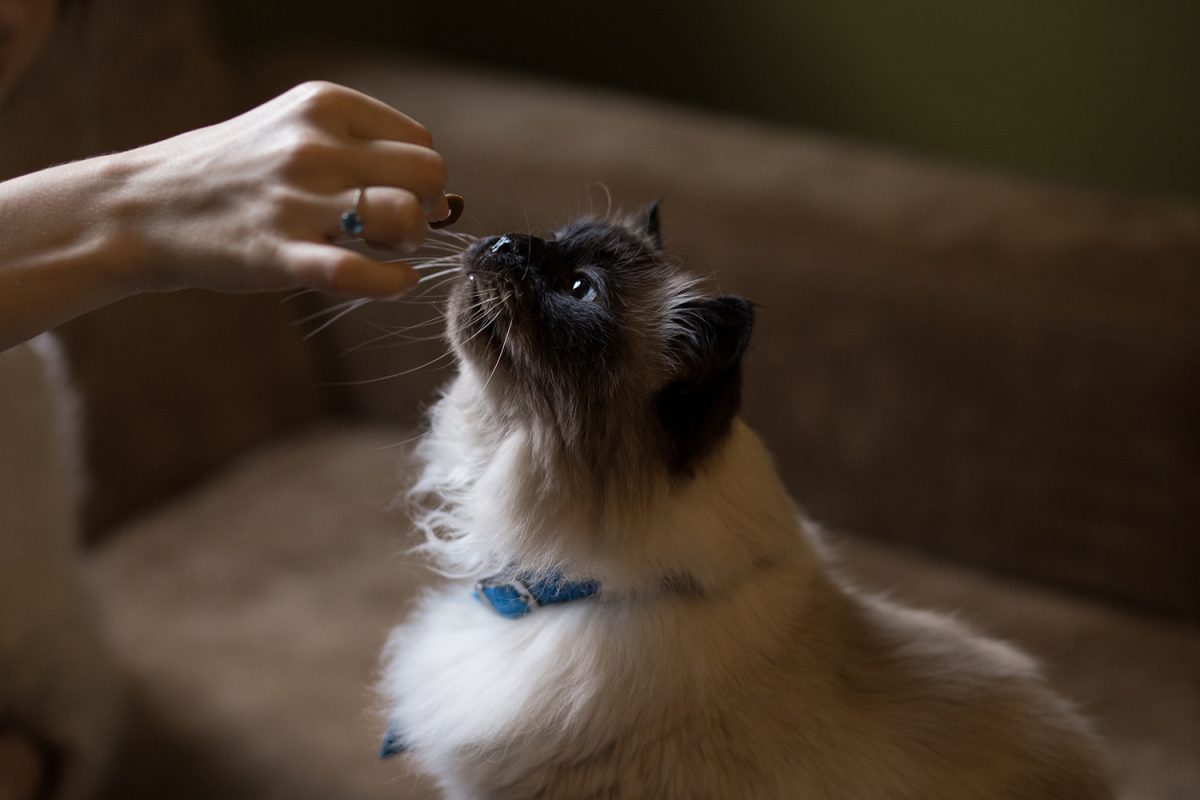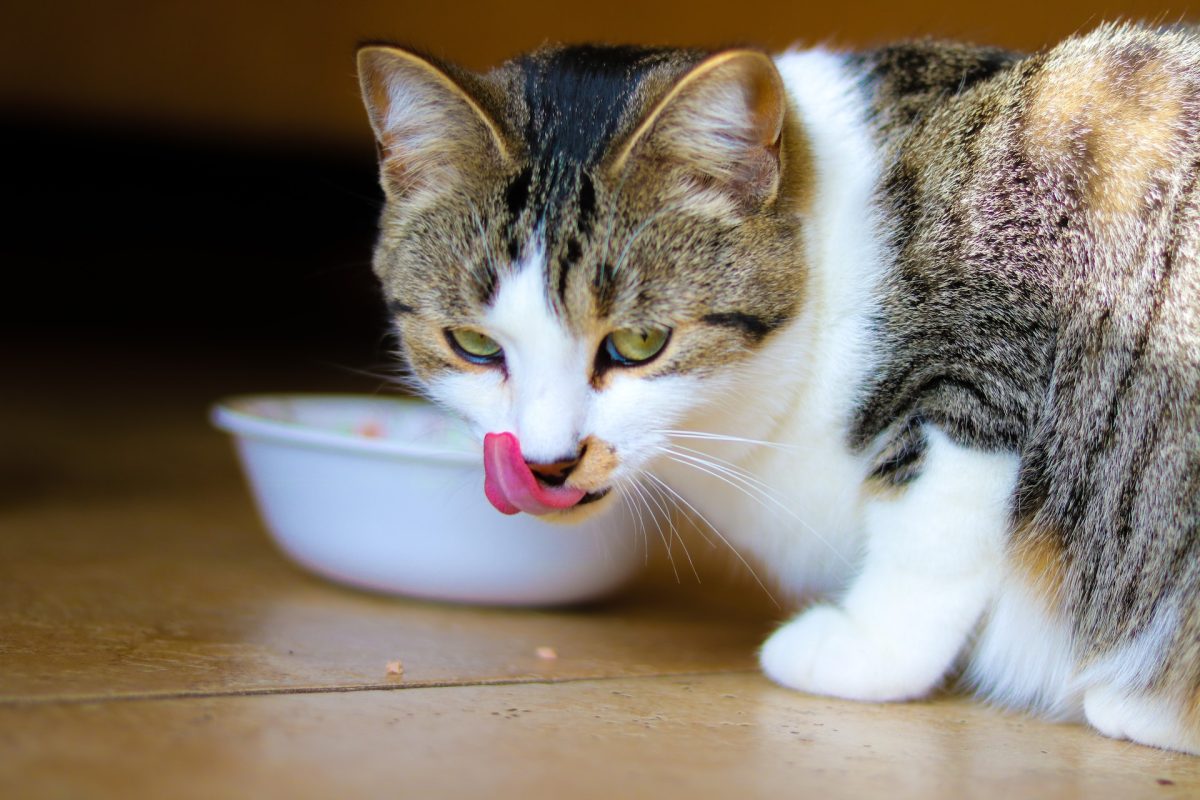
6 Tips for Feeding Your Cat
31 Jan 2021.
Our furry friends can be fussy eaters. Finding a routine to suit our purring prince or princess can be difficult. With so many products and food types available, it’s hard to know what’s best to give to our cats, how often and when. To help Cat in a Flat here answers some of the most frequently asked questions about feeding kitties.
Table of contents
1. How often should I feed my cat?
Cats are all individuals, and no answer will work for all kitties. However, a good guideline is to feed your cat twice a day – in the morning and evening. Some cats require more frequent feeding times than this. For example, kitties who wolf their food and then vomit might benefit from being fed four smaller meals. Similarly, elderly or infirm cats might prefer smaller and more frequent meals throughout the day.
Remember to brief your cat sitter on Mr Whisker’s preferences before they care for your cat. Cats don’t like change so keeping a regular feeding schedule is important.
2. Is my cat eating too much or too little?
The amount of food your cat requires depends on your cat’s size, how active they are, whether they are an indoor or outdoor cat, and how old they are. Growing kittens will need more calories relative to their size than a sleepy elderly cat. A vet can advise on the number of calories your kitty should consume, but an average adult cat needs around 270-300kcals a day. In context, 100g of dry food has around 350-500kcal, and 100g of wet food has around 140kcal though this will vary between brand and food type.
The amount of food can comprise dry and wet food, but be aware that some foods are far higher in calories than others and adjust the amount you are feeding your cat. Don’t forget to include the calories of treats too! Always read the recommended feeding amounts on food packaging, to find out how much to feed your cat depending on their size.

When fully grown, your cat should stay at a pretty constant weight suited to its frame. Your vet can guide you on your cat’s ideal weight range and advise if your cat is putting on, or losing weight. You can also check your cat’s weight by getting on the scales without and then with your cat, and working out the difference. As a primary indicator, a cat at a healthy weight should have a defined waist, and you should be able to feel the outline of their ribs and backbone easily. If you are worried that your cat looks thin and their ribs and bones are too prominent, take them to your vet. A professional can make sure your cat is healthy and advise on how they can gain weight safely.
Important: If your cat suddenly loses or gains weight, speak to your vet as soon as possible. Sudden fluctuations in weight can be a sign of an underlying issue.
The position of and the area around your cat’s bowl are also essential to consider as part of their feeding routine. Cats feel vulnerable when eating. With their head in a bowl, it’s impossible to monitor their surroundings for potential threats. It’s best to position food bowls somewhere quiet and away from doors, windows and corridors. Nervous kitties will prefer to look out on the surrounding room and have their backs pointed at the wall. This position means they don’t have to worry about what’s going on behind them.
Cats also prefer to eat away from their litter tray. In the wild felines don’t want strong scents close to their nest as it tells enemies where they are. Domestic cats still have this instinct, so would prefer to toilet far away from their food bowl.
3. Why does my cat refuse to drink water from its bowl?
Many kitties confuse their owner by ignoring their freshly replenished drinking bowl and instead, drinking from a puddle, drips from the tap or an old glass of water. But why do they do this?
The position of your cat’s water bowl can influence how keen they are to take a drink. Cats prefer to drink away from where they eat. This behaviour is probably related to their wild cousins hunting and killing away from watering holes to prevent carcasses contaminating the water.
As with food bowls, cats also don’t like their water near litter trays. Cats are fastidious about cleanliness and smell, and won’t want to drink water near their toileting area. Why then do many cats like drinking from puddles? Water may seem to have no odour to us but can smell strongly of chemicals to our kitties. That’s why an old glass of water or puddle can seem more tempting than a fresh bowl.
Cats also seem to prefer to drink from a running rather than a still water source. In the wild, running water is more likely to be fresh and uncontaminated than still pools. Cat drinking fountains that circulate water can prove useful in encouraging kitties to drink. Many come with a filter to remove unpleasant smells too.
Some cat bowls too could have a smell or shape that puts kitty off their water. Many kitties don’t like getting their whiskers wet or for them to hit the side of their bowl. A shallower bowl can help with this. Some bowls, especially those made of plastic, can have an offputting smell for cats. Try switching to ceramic, metal or glass to see if the change in material soothes Mr Whisker’s sensitive nose.
4. Is wet or dry food better for my cat?
There isn’t a definite answer as to whether wet or dry food is better for cats. The decision of what to feed your cat will often come down to individual preference and convenience.

Wet food has the advantage of containing moisture, which is beneficial for cats who don’t like to drink water. Hydrated cats are less likely to suffer from urinary tract infections and kidney disease. Many kitties prefer the taste and smell of wet food, so it can help to encourage fussy cats to eat. Cats that need to lose weight might also benefit from a wet food diet as it tends to have fewer calories by volume than dry food.
Dry food is generally better for your cat’s teeth and can help prevent the build-up of plaque and tartar. Kibble is also a lot slower to spoil, so owners can leave it out for more extended periods for cats to graze on, though be warned this can lead to overeating.
The most important thing is to give your cat food that is nutritionally complete and to make sure you’re serving the correct portion for Mr Whisker’s size. Many owners like to serve both wet and dry food, so their kitty benefits from both types of food.
5. Why do some cats like to be stroked while eating?
Some kitties are social eaters. If your furry friend likes to be around you when eating, it could be because you make them feel safe. As mentioned previously, cats are at their most vulnerable when they eat. If you’re there to protect them, however, they can relax and enjoy their meal. For some cats, being stroked is the ultimate expression of this security. Even if they can’t see you, they can feel you petting them, making them feel soothed and safe.
You may even be able to befriend a shy cat by petting them while they eat. Skittish cats who would usually run away or scratch may allow you to stroke them during dinner time.
If cat sitting a kitty for the first time, feeding time could be a great time to bond with your new furry friend. Check with Mr Whiskers’ owners first to make sure he tolerates interaction when eating. If he enjoys pets at the same time as food, it’s the perfect occasion to get to know each other.
6. Why does my cat eat grass?

Chewing on greenery might seem like an odd habit for a carnivore. However, cats will often indulge in a little grass-eating if they have access to it. The main reason seems to be that grass acts as a digestive aid for kitties and can help soothe an aching stomach. The fibre in grass helps remove blockages in the gut and can act as an emetic, making your kitty vomit something bothering their tum.
Cats also tend to chew on things when they are stressed and anxious, including grass and plants. Indoor cats who don’t have access to a garden might benefit from a patch of cat grass in the home. Without access to greenery, cats might chew on house plants, and many are toxic to kitties.
For more information on cat eating habits including whether kitties can be vegan, why cats vomit and why Mr Whiskers loves catnip, read more on the Cat in a Flat blog.


